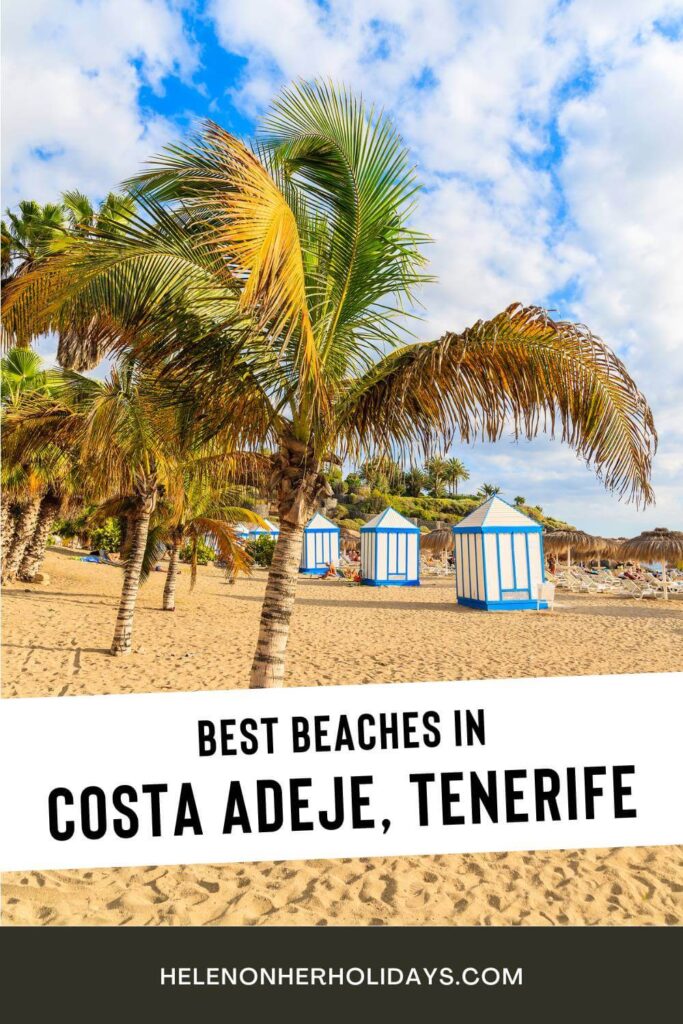Are you visiting Costa Adeje and wondering which beaches are best to visit? There are lots of wonderful Costa Adeje beaches, each with their own atmosphere, so picking the right one could be key to having a great holiday in Tenerife.
Costa Adeje has some of Tenerife’s best beaches. I’ve visited every beach in Costa Adeje, and in this post I’ll tell you everything you need to know about each one. From Playa de Troya on the border with Playa de las Americas, to Playa La Caleta to the north of the resort, don’t miss this complete guide to the best beaches in Costa Adeje.
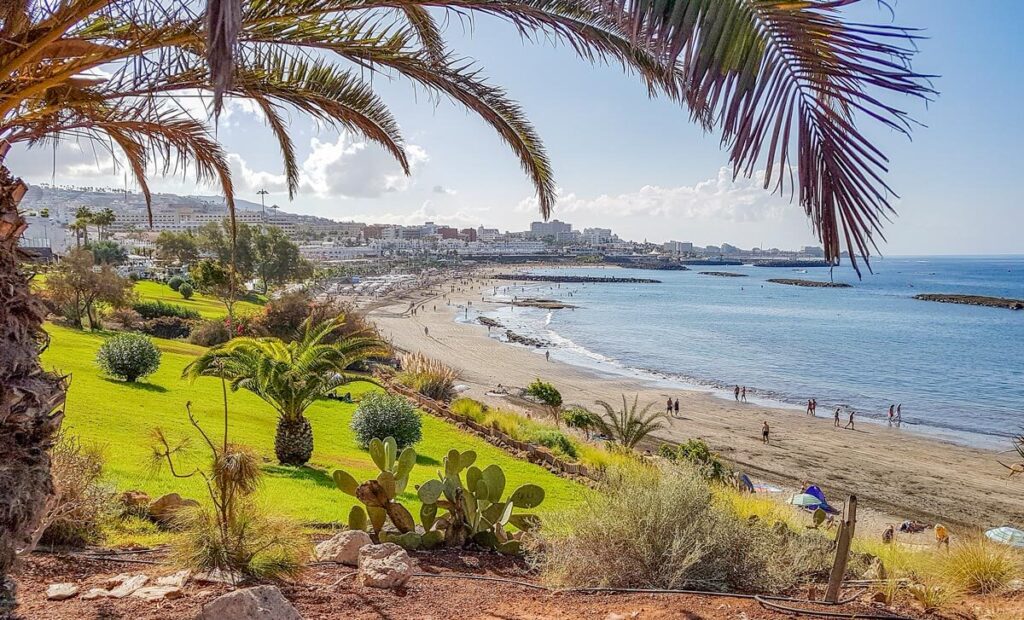
Playa de Troya
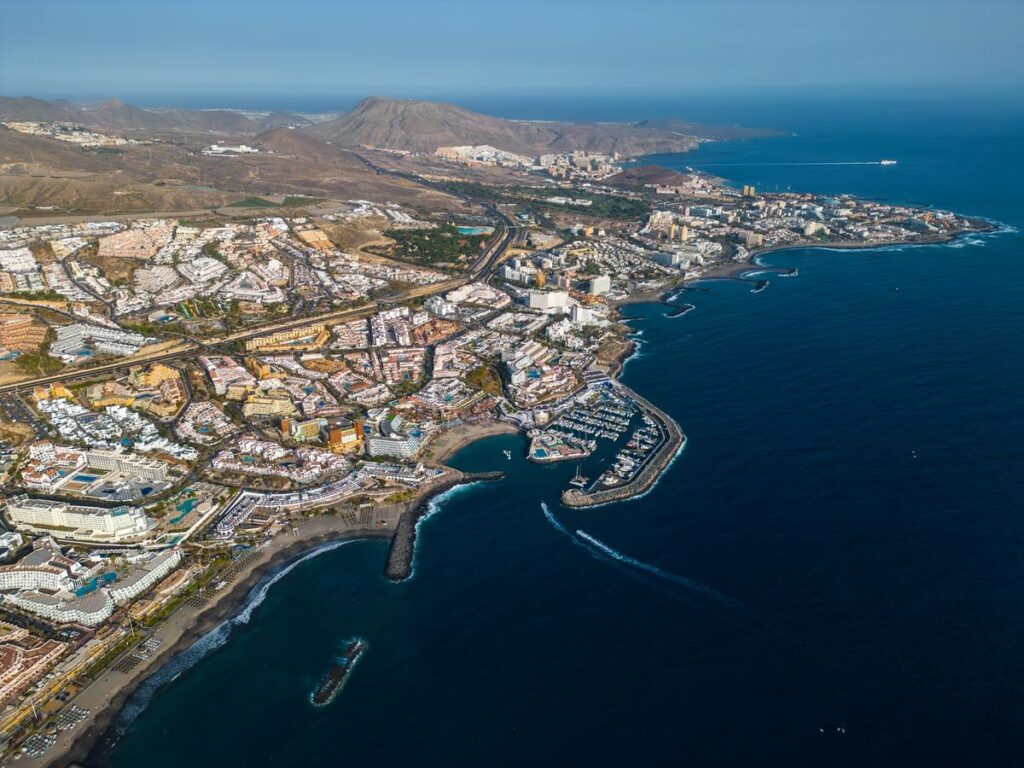
Type: Dark golden sand
Sun beds to rent: Yes, from €6 per day
Suitable for swimming: Yes
Facilities: Public toilets (for a fee), showers, lifeguard
Playa de Troya is just past the border between Playa de las Americas to the south and Costa Adeje to the north. Like most beaches in Tenerife, the sand at Playa de Troya is dark and can get very hot, so make sure you have flipflops or sandals for walking on the sand.
Towards the northern end of the beach it gets more pebbly, and it ends with a narrow, grassy park, from where there are lovely views over the beach, the sea, and La Gomera on the horizon.
The sea is nice and clear and generally good for swimming, although it can get a little choppy at times so you may want to find calmer waters if you’re not a strong swimmer.
The beachfront promenade from Los Cristianos to La Caleta runs right behind the beach and has plenty of amenities like shops, bars and restaurants.
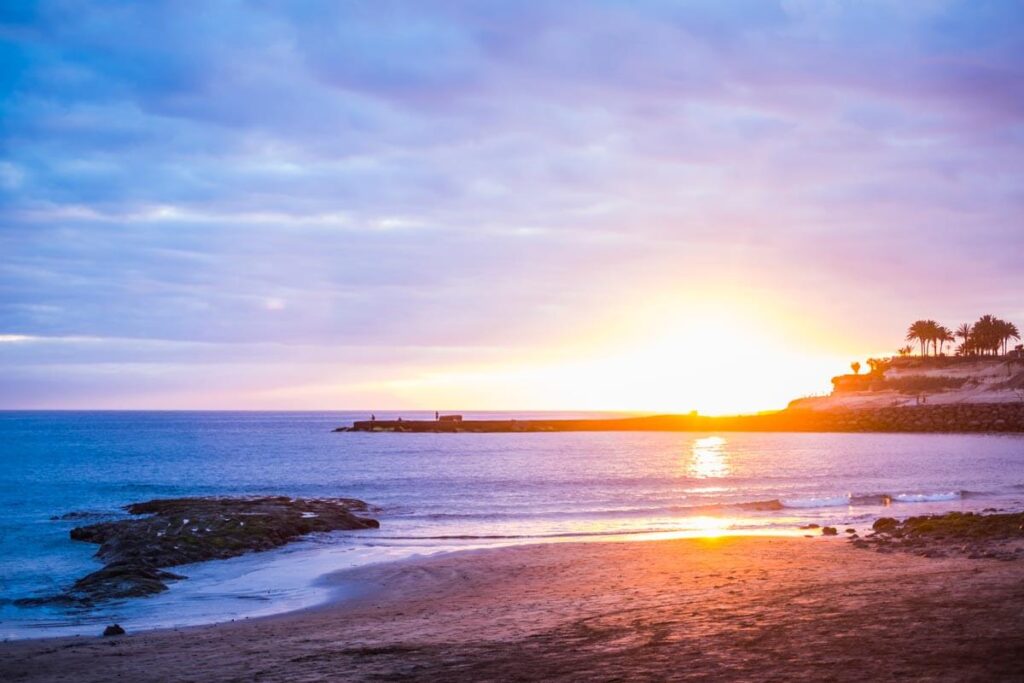
Playa de Troya is one of the best places in this part of Tenerife to see the sun set. There are a few beach bars with unobstructed views of the beautiful sunsets over the ocean. One of the best is the huge Monkey Beach Club, which hosts DJ sets on the rooftop; the perfect spot to watch the sun go down.
Playa de el Bobo
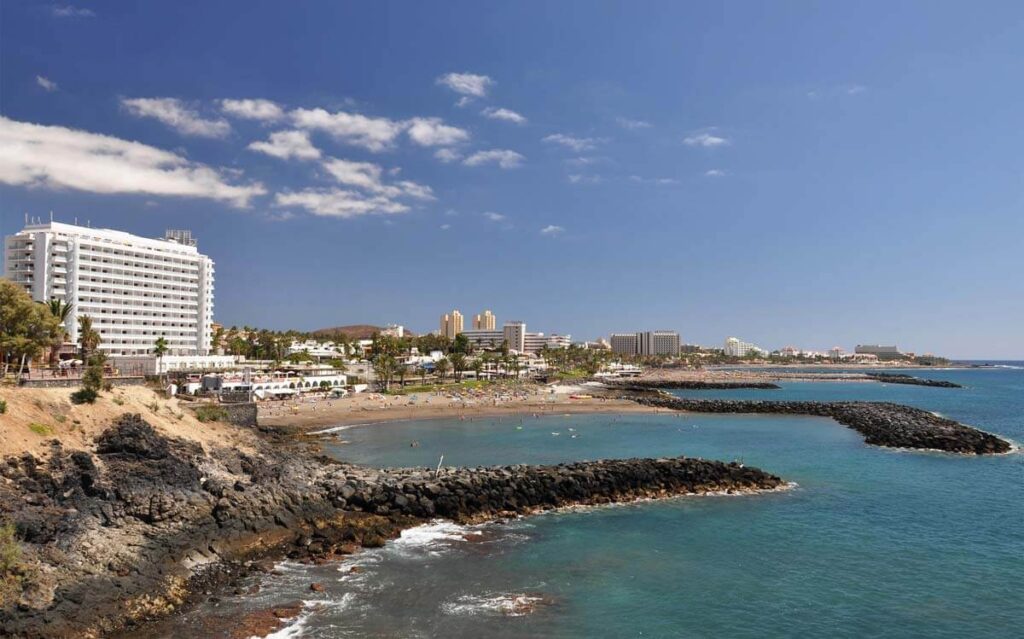
Type: Dark golden sand
Sun beds to rent: Yes, from €6 per day
Suitable for swimming: Yes
Facilities: Showers, lifeguard
Playa de el Bobo is the next beach you’ll come to on the coastal path as you head north from Playa de las Americas.
Playa de el Bobo is one of the smaller beaches in Costa Adeje and is a cove of soft dark sand between two breakwaters. The angle of the breakwaters and the curve of the bay mean that this beach has some of the calmest waters in the area; for that reason, it’s popular with families with young children. The shallow waters and shelter mean it’s also often a little warmer than other Costa Adeje beaches.
There are some rock pools where you can find crabs, and you’ll see fish in the water.
There are fewer restaurants right on the beach here, but there are plenty nearby. Parking is also very easy, with underground parking just around the corner.
There’s a nice viewpoint just off the seafront walkway, with views out to sea and plenty of places to sit.
Playa de la Pinta
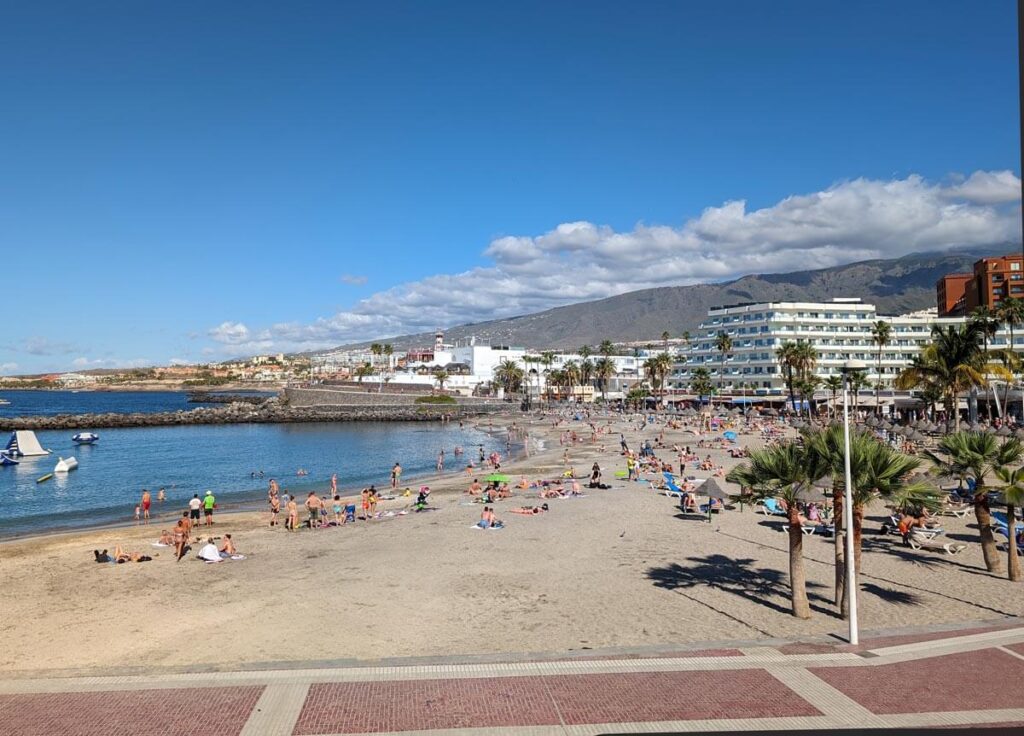
Type: Golden sand
Sun beds to rent: Yes, from €6 per day
Suitable for swimming: Yes, but limited because of the harbour
Facilities: Showers, lifeguard
From Playa de el Bobo to Puerto Colon, the coastline is rocky, so the next Costa Adeje beach you’ll come to is Playa de la Pinta, also known as Puerto Colon beach.
Puerto Colon is a busy harbour with lots of small boats coming in and out. It’s the starting point for most whale watching trips in Costa Adeje, along with parascending, jet ski excursions, scuba diving and boat trips to Los Gigantes. Even if you don’t take to the water yourself, seeing the boats coming in and out of the harbour is a nice backdrop to your Costa Adeje beach day.
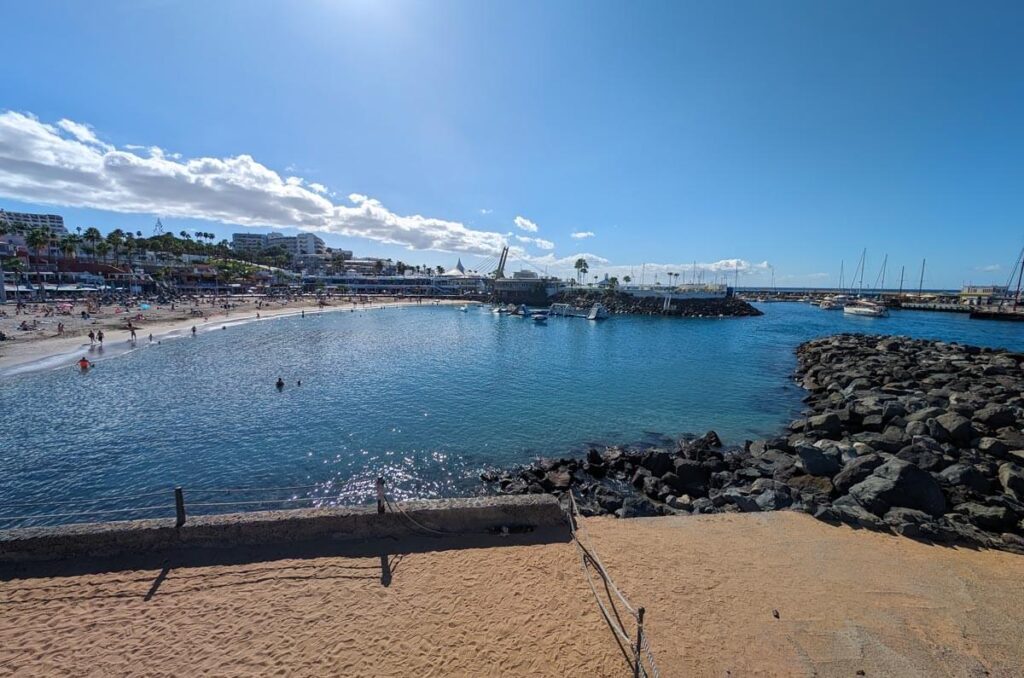
Playa de la Pinta is a busy, fun-loving family beach, with lots of watersports and a water park. The sand here is more golden than at other beaches, so if you’re looking for a classic bucket and spade experience with the kids, Playa de la Pinta could be a great place for your family. This is another quite sheltered beach, with calm waters and fewer breezes than Playa de Torviscas to the north.
Playa de la Pinta is lined with good-value bars and numerous restaurants, along with shops and places to book excursions from Puerto Colon. It’s no surprise that it’s one of the most popular beaches in Tenerife.
Playa de Torviscas and Playa de Fañabé
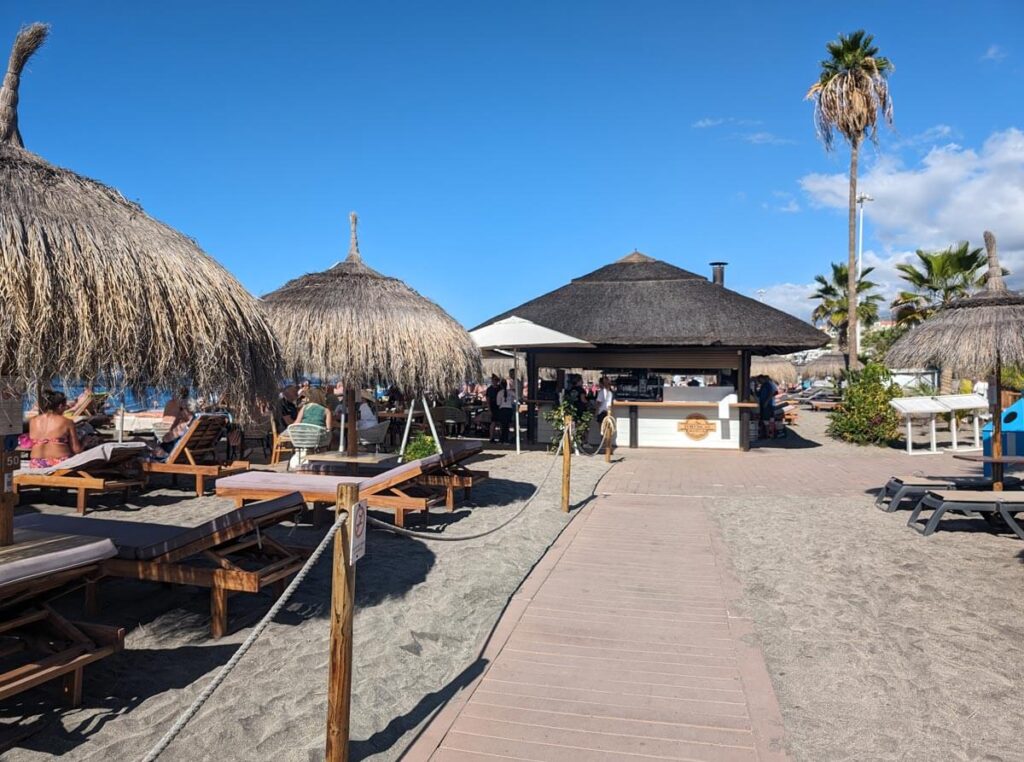
Type: Dark sand
Sun beds to rent: Yes, from €14 per day
Suitable for swimming: Yes
Facilities: Public toilets, showers, lifeguard, lockers, safety boxes, accessible bathing
Playa de Torviscas and Playa de Fañabé are two beaches that merge together to form a wide strip of dark sand nearly 1 kilometre long. Together, they’re Costa Adeje’s main beach, but because there’s so much space, they don’t feel as busy as Playa de la Pinta.
The soft, dark sandy beach shelves gently into the sea and the water is nice and calm for swimming. Because Playa de Torviscas and Playa de Fañabé are less sheltered than the coves of Playa de la Pinta and Playa de El Bobo, they can be a little more breezy.
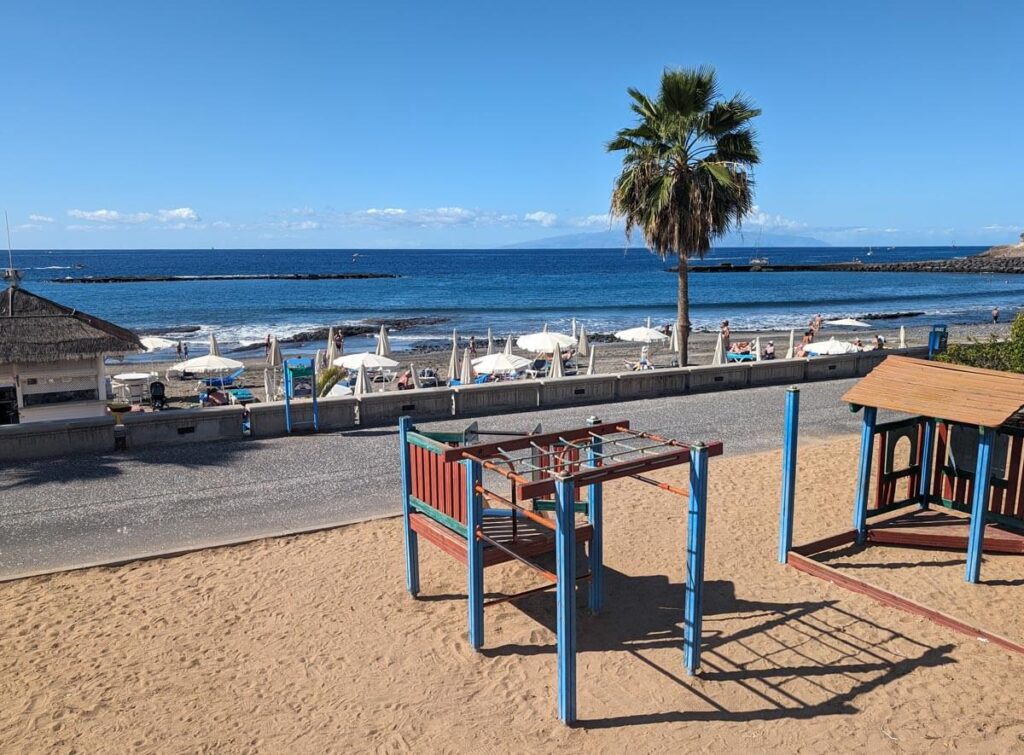
These two beaches are still very family friendly, with play areas spread along the seafront promenade, a mini golf course, bowling, trampolines and other fun things to do for both big and small children.
This area is also very popular with people driving motorised scooters as the wide, flat promenade with sloped access makes getting here easy. If you, or someone you’re travelling with uses a wheelchair, Torviscas Beach has facilities for adapted swimming, making it one of the best beaches in Tenerife for accessibility.
Playa de Torviscas is the southern part of the beach and has a wider variety of shops and restaurants, along with a McDonalds, Burger King and public toilets.
Playa Fañabé sees the beginning of Costa Adeje’s upmarket side, with Le Club beach club charging up to €100 per day for a double sun bed on the beach. There are some cheaper sun loungers further back.
To the northern end of Fañabé Beach, you’ll find two large grassy areas above the free part of the beach; there are some interesting rocks at the far end underneath the Playa Fañabé sign. If you head to the end of the breakwater nearby, the rocks are full of cute little crabs.
Playa del Duque
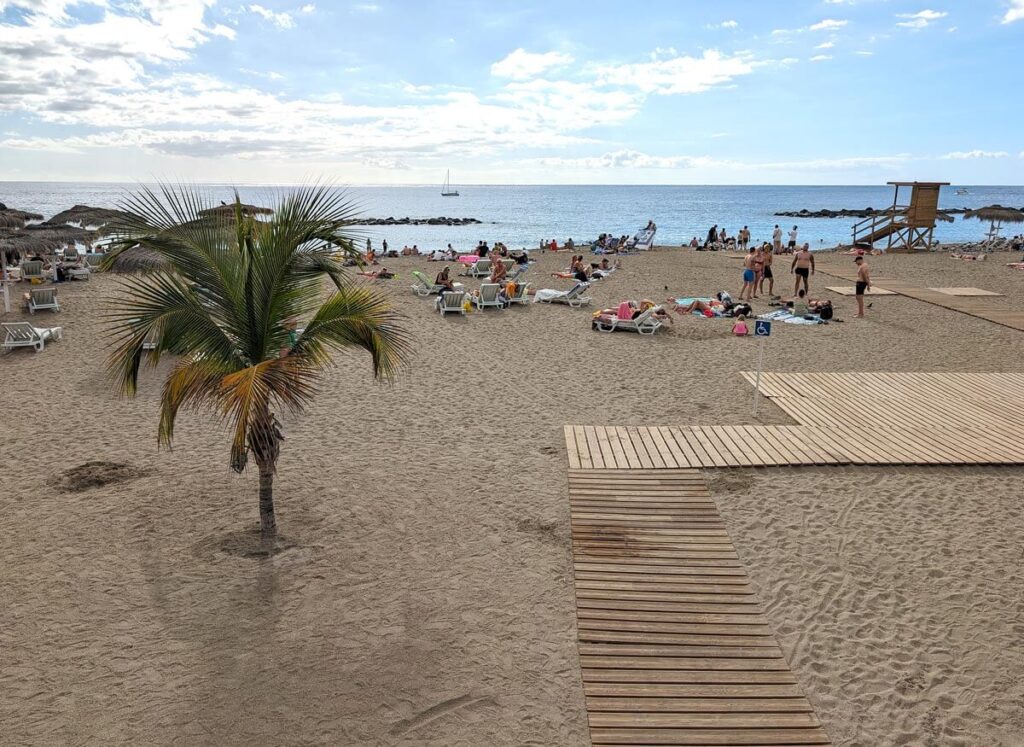
Type: Golden sand in the south, black volcanic sand in the north
Sun beds to rent: Yes
Suitable for swimming: Yes, but only for strong swimmers due to powerful currents
Facilities: Toilets, showers, first aid, accessible beach
Playa del Duque (Duke’s Beach) is the most beautiful Costa Adeje beach for a relaxing day in the sun. It’s a beach of two halves, with the southern part of the beach (Playa del Duque Sur) made of golden sand and the northern part (Playa de Duque Norte) being much more typical of this part of the Canary Islands, with small black pebbles.
I really enjoyed the contrast; halfway along the beach the sand literally changes from golden to black. The golden sand is very pretty but the black volcanic beach is really dramatic.
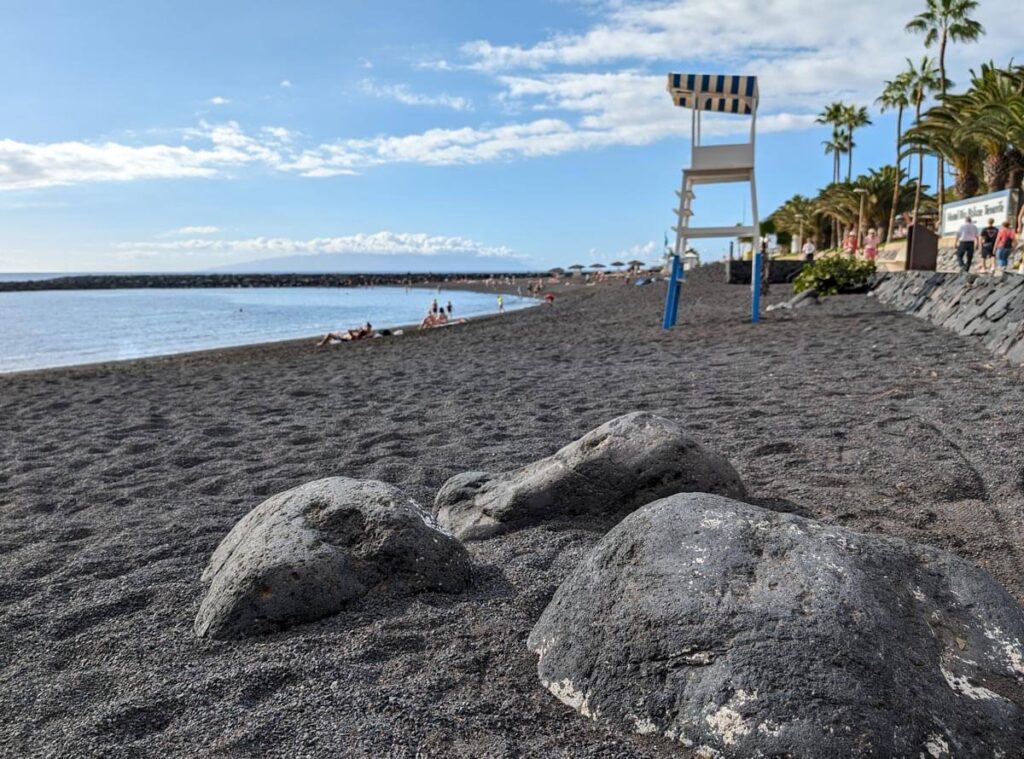
The turquoise water at Playa del Duque beach looks very inviting. It’s a Blue Flag beach, with the water cleanliness to match, but there are some strong currents and unpredictable waves, particularly on the left hand side of the beach. For that reason, it’s not the best beach in Costa Adeje for families with young children or weak swimmers.
There’s a sobering reminder of the danger of the sea on the beachfront promenade. A statue here is dedicated to the memory of Javier Pérez Ramos, a beach worker who died rescuing a girl who’d got into trouble in the water in 1998.
This part of Costa Adeje is full of 5 star luxury hotels and there are plenty of classy cafes and restaurants along this beach which cater to the hotels’ clientele. The signs advertising pints of local beer for €1.50 that you’ll see on the more southerly beaches are noticeably absent at Playa del Duque!
Barranco del Agua
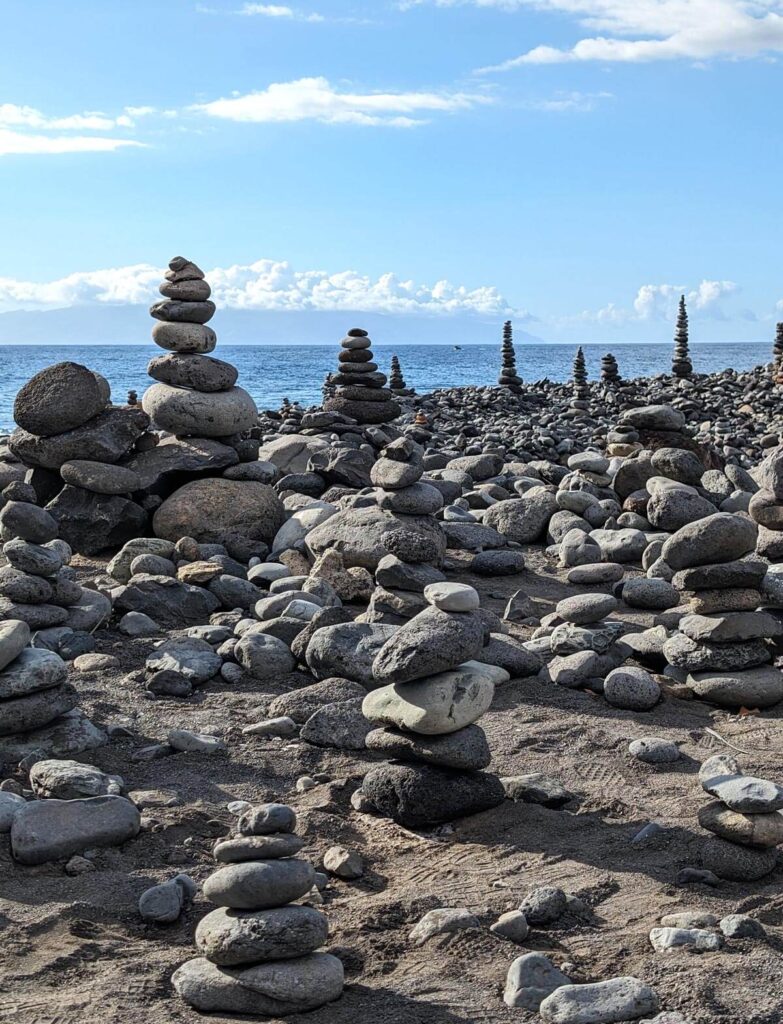
This isn’t really a Costa Adeje beach but I just had to mention it as it’s a really interesting spot! Just north of Playa del Duque you’ll pass Barranco del Agua, a dry water channel built to direct the occasional flash flood to the sea. Thousands of rocks have been washed down the channel and visitors have had lots of fun stacking them to create an otherworldly landscape. It’s strange and very beautiful.
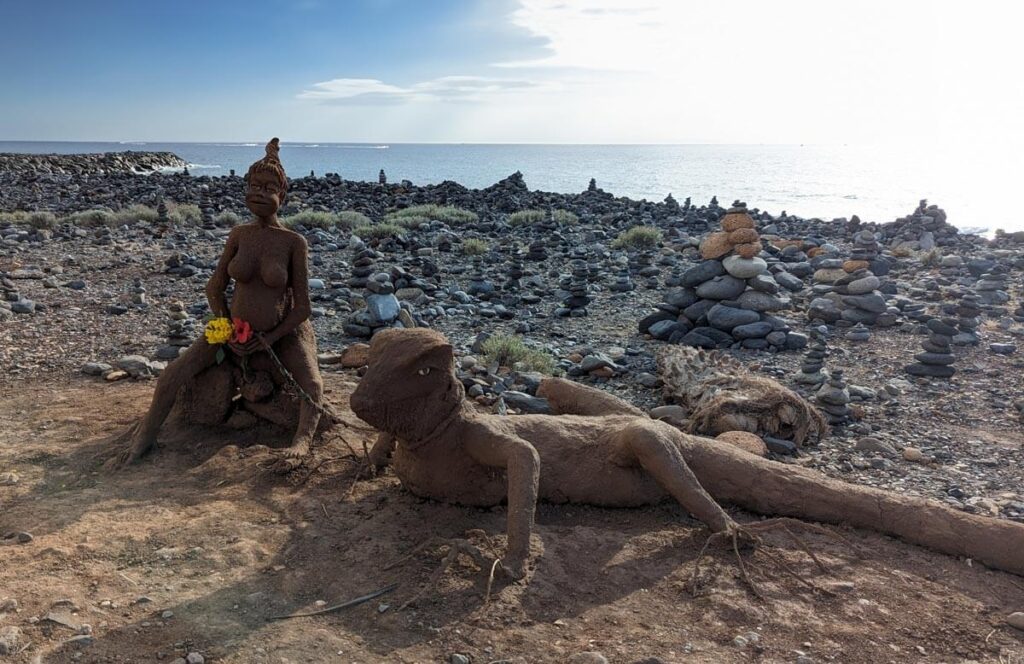
There’s more otherworldly beauty a little further along, where you can see sand sculptures which have been created among the rock towers. There was also someone playing a handpan drum. It was all very peaceful and more like what you’d expect to find in Ibiza than the Canary Islands.
Playa de la Enramada
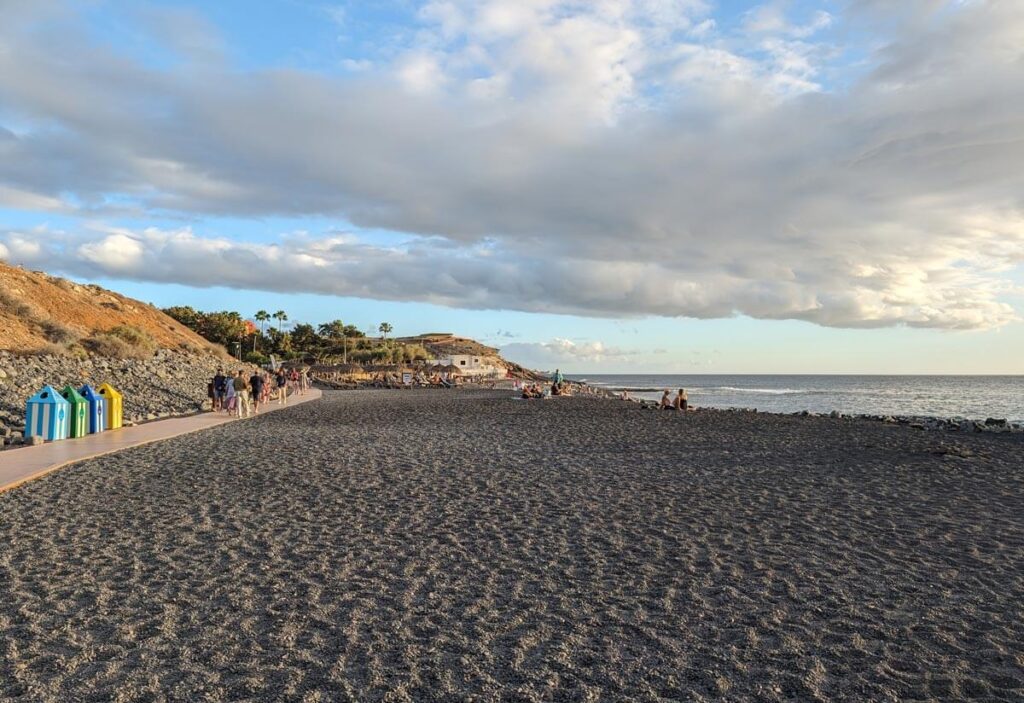
Type: Fine black gravel
Sun beds to rent: Yes, from €12
Suitable for swimming: Yes, but only for strong swimmers due to powerful currents
Facilities: Toilets, accessible beach
My favourite beach in Costa Adeje is Playa de la Enramada, a beautiful beach on the border between Costa Adeje and La Caleta.
It has a more unspoilt, wild feel than some others in the area, despite the fact that the volcanic sand has been brought in from Los Cristianos. It’s sometimes known as Playa del Veril at its southern end. There’s a lovely beach bar here called Coqueluche with great sunset vibes and live music, but the main attraction here is in the air.
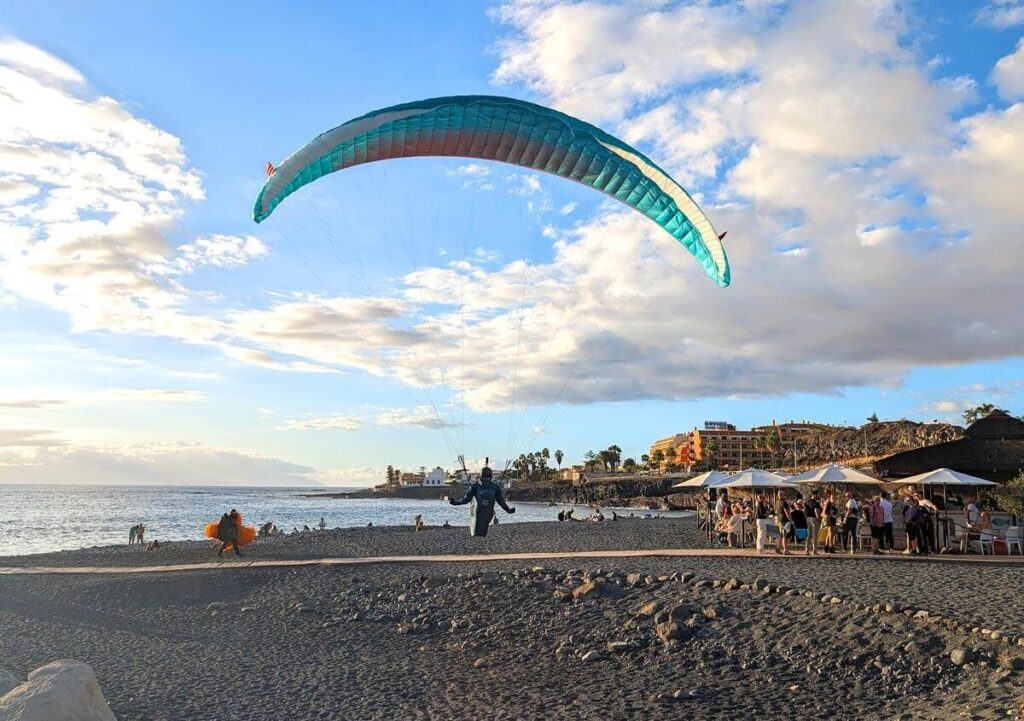
In the late afternoon, paragliders come in to land on Enramada beach, right next to drinkers at the beach bar. It’s a big part of why the bar is so popular – you can watch them gliding above you, then lining up along the Barranco del Inglés to come in for impossibly gentle landings on the beach. Be careful crossing the Barranco as you could get clipped on the head by someone’s feet!
If you fancy taking to the skies yourself, you can do a tandem paraglide without needing any prior experience.
You can swim at Playa de la Enramada but there are strong currents, so it’s not suitable for children or weak swimmers.
Playa La Caleta
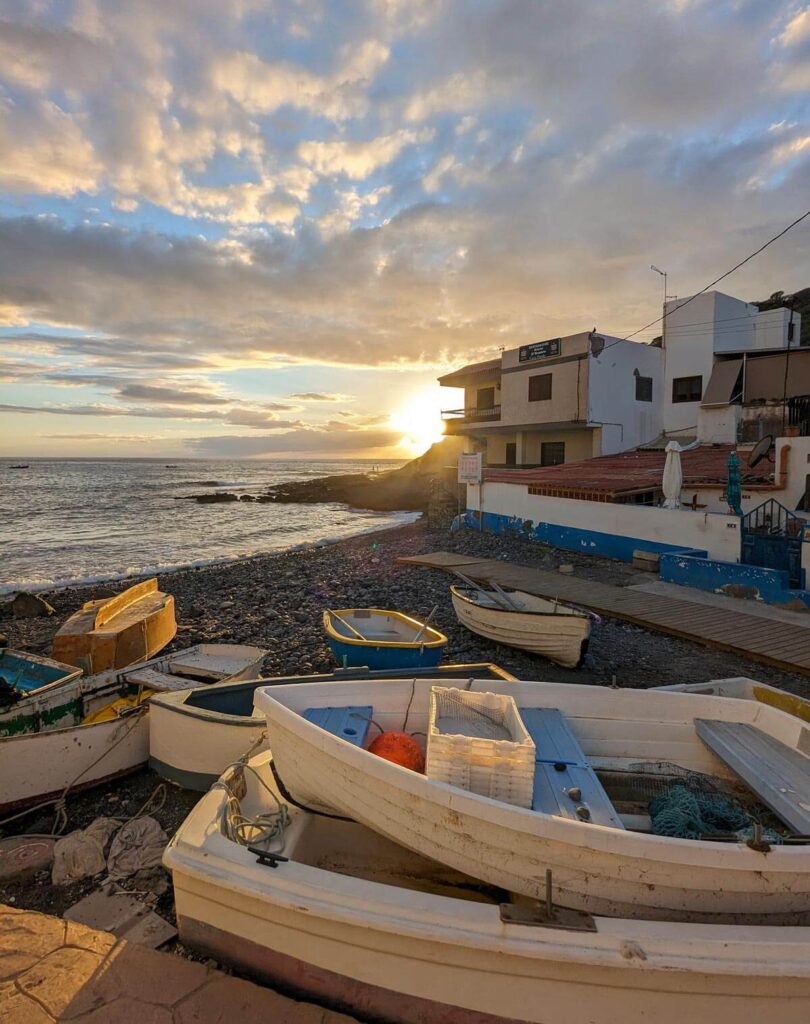
Type: Flat rocks and pebbly beaches
Sun beds to rent: No
Suitable for swimming: Yes, for experienced swimmers and snorkelers
Facilities: None, but there are bars, shops and restaurants in the village
While La Caleta is a village in its own right rather than being part of Costa Adeje, I’ve included it here as it’s the final stop on the beachfront promenade.
La Caleta is a fishing village that’s becoming increasingly touristy but still has a lot of charm, particularly on the seafront. The “beaches” in La Caleta are stretching the definition a bit – they’re mostly either natural rocky outcrops that are used as bathing platforms or narrow pebbly strips. The crystal clear waters and rockpools make it great for spotting fish, crabs and other sea life, and for snorkelling.
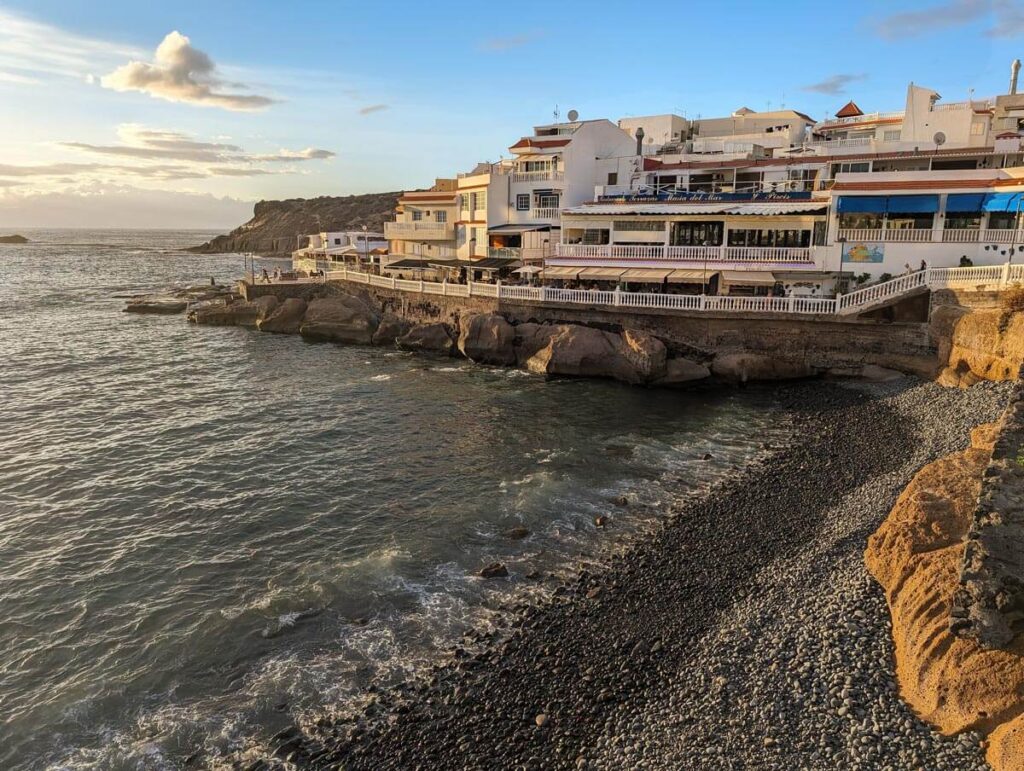
The largest beach in La Caleta and the most charming is the small bay in the heart of the village. It’s a particularly beautiful spot for sunset, with little fishing boats pulled up on the shore and the sun disappearing around the headland.
La Caleta has a handful of bars and places to eat, including some very upmarket fish restaurants on the coastline serving some of the island’s finest seafood. If you want to dine overlooking the ocean then it’s highly advisable to book in advance.
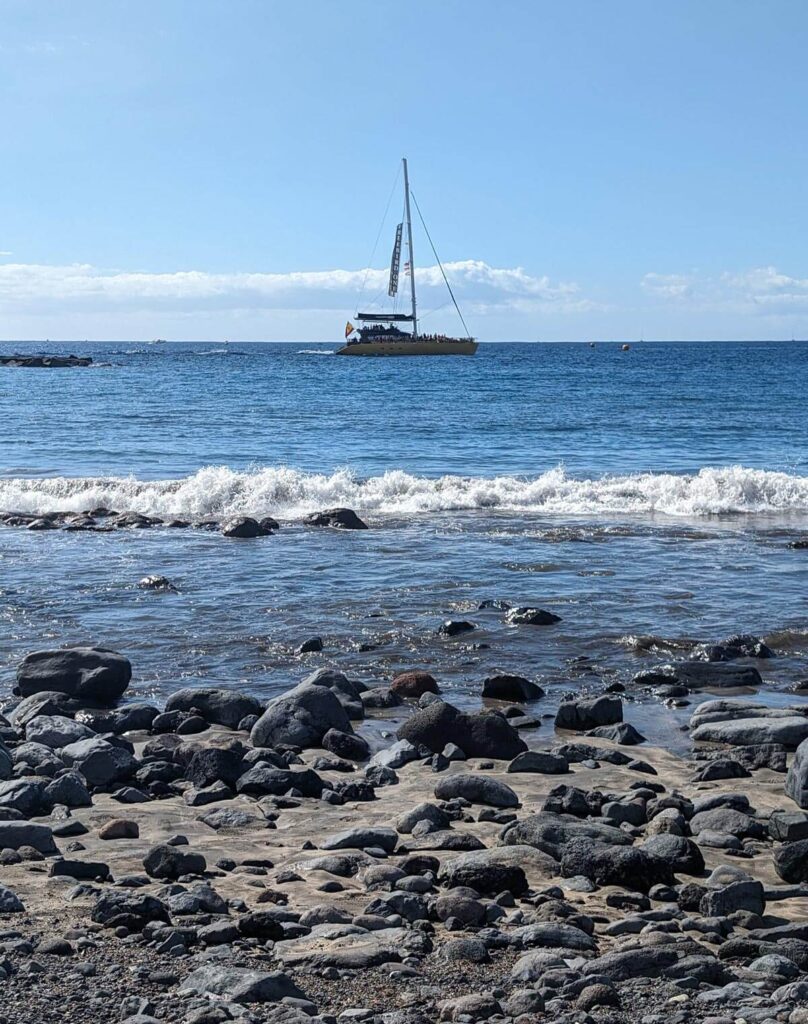
In summary
Thank you for reading my guide to the best Costa Adeje beaches. I hope it helps you have a wonderful trip to Tenerife.
If you want to get more out of your Costa Adeje holiday, why not take a look at my 7 day Costa Adeje itinerary, which is packed with things to do both in the resort and on day trips around the island, including to Teide national park
Which beach would you choose in Costa Adeje?
Pin it for later!
